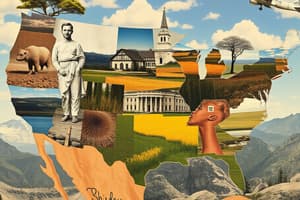Podcast
Questions and Answers
What is the primary role of ecosystem diversity in an area?
What is the primary role of ecosystem diversity in an area?
- Facilitates urban development
- Increases fossil fuel production
- Reduces wildlife populations
- Enhances resilience against environmental changes (correct)
Which of the following is NOT a type of ecosystem?
Which of the following is NOT a type of ecosystem?
- Terrestrial
- Industrial (correct)
- Desert
- Aquatic
Which factor significantly contributes to climate change?
Which factor significantly contributes to climate change?
- Urban green spaces
- Increased biodiversity
- Greenhouse gas emissions (correct)
- Soil preservation
What is one of the main effects of climate change on biodiversity?
What is one of the main effects of climate change on biodiversity?
Which conservation strategy aims to protect ecosystems from development?
Which conservation strategy aims to protect ecosystems from development?
What is one method to mitigate climate change?
What is one method to mitigate climate change?
Which of the following is a direct threat to ecosystem diversity?
Which of the following is a direct threat to ecosystem diversity?
What is a potential consequence of ocean acidification?
What is a potential consequence of ocean acidification?
Flashcards are hidden until you start studying
Study Notes
Ecosystem Diversity
- Definition: Variety of different ecosystems within a given area.
- Types of Ecosystems:
- Terrestrial (forests, grasslands, deserts)
- Aquatic (freshwater, marine)
- Importance:
- Supports biodiversity, providing habitats for various species.
- Contributes to ecosystem services (pollination, water purification).
- Enhances resilience against environmental changes and disasters.
- Threats:
- Habitat destruction (urbanization, deforestation).
- Pollution (air, water, soil).
- Climate change (shifts in temperature and precipitation patterns).
- Invasive species (displacing native flora and fauna).
- Conservation Strategies:
- Protected areas (national parks, wildlife reserves).
- Sustainable practices (agriculture, forestry).
- Restoration projects (rehabilitating degraded ecosystems).
Climate Change
- Definition: Long-term alteration of temperature and typical weather patterns in a place.
- Causes:
- Greenhouse gas emissions (CO2, methane, nitrous oxide from burning fossil fuels).
- Deforestation (reduces carbon storage capacity).
- Industrial processes and agriculture (contributes to emissions).
- Effects:
- Rising global temperatures (average increase over the past century).
- Melting ice caps and glaciers (increased sea levels).
- Increased frequency and intensity of extreme weather events (hurricanes, droughts).
- Biodiversity loss (altered habitats, species extinction).
- Ocean acidification (affects marine life).
- Mitigation Strategies:
- Transition to renewable energy sources (solar, wind).
- Energy efficiency improvements (buildings, transportation).
- Reforestation and afforestation (planting trees to absorb CO2).
- International agreements (Paris Agreement, emissions reduction targets).
Ecosystem Diversity
- Definition: Represents the variety of distinct ecosystems present in a specific region, crucial for sustaining life.
- Types of Ecosystems:
- Terrestrial: Includes forests, grasslands, and deserts, each with unique species and ecological functions.
- Aquatic: Divided into freshwater ecosystems (lakes, rivers) and marine ecosystems (oceans, coral reefs), vital for many species.
- Importance:
- Underpins biodiversity, offering habitats for myriad species which maintain ecological balance.
- Provides essential ecosystem services such as pollination for food crops and water purification for drinking.
- Improves resilience to environmental fluctuations, such as natural disasters and climate change effects.
- Threats:
- Habitat Destruction: Driven by urbanization and deforestation, resulting in loss of species and ecosystems.
- Pollution: Air, water, and soil contamination that adversely affects ecosystem health.
- Climate Change: Alters temperature and precipitation patterns, threatening ecosystem stability.
- Invasive Species: Non-native species that disrupt and displace local flora and fauna, leading to ecosystem imbalance.
- Conservation Strategies:
- Establishment of protected areas like national parks and wildlife reserves to safeguard ecosystems.
- Implementation of sustainable practices in agriculture and forestry to minimize environmental impact.
- Restoration initiatives to rehabilitate degraded or damaged ecosystems, promoting recovery of biodiversity.
Climate Change
- Definition: Refers to long-term alterations in temperature and typical weather patterns, significantly impacting various regions.
- Causes:
- Greenhouse gas emissions, including carbon dioxide, methane, and nitrous oxide, primarily from fossil fuel combustion.
- Deforestation, which compromises trees' ability to absorb carbon dioxide, exacerbating climate issues.
- Contributions from industrial processes and agriculture that further elevate greenhouse gas levels.
- Effects:
- Rise in global temperatures, with significant average increases noted over the past century impacting weather patterns.
- Melting ice caps and glaciers leading to rising sea levels, threatening coastal habitats and human settlements.
- Increased frequency and severity of extreme weather events, such as hurricanes and droughts, resulting in economic and environmental damage.
- Biodiversity loss caused by habitat alteration, leading to potential species extinction.
- Ocean acidification affects marine ecosystems, altering species interactions and food webs.
- Mitigation Strategies:
- Transition to renewable energy sources like solar and wind power to reduce dependence on fossil fuels.
- Enhancements in energy efficiency in sectors such as building design and transportation to lower overall emissions.
- Reforestation and afforestation efforts to increase tree cover, enhancing carbon absorption capabilities.
- Participation in international agreements, such as the Paris Agreement, aimed at setting and achieving emissions reduction targets globally.
Studying That Suits You
Use AI to generate personalized quizzes and flashcards to suit your learning preferences.




